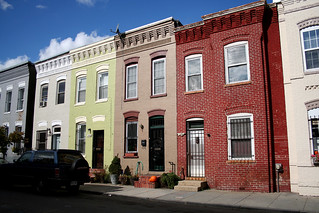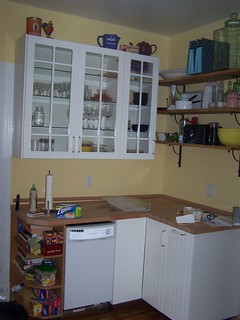If you gut a house and make it modern is it still "historic"?
 Today's Washington Post Magazine features a story, "A Marriage of Styles," on the "renovation" of a historic rowhouse.
Today's Washington Post Magazine features a story, "A Marriage of Styles," on the "renovation" of a historic rowhouse.Looking at the various interior photos, much of the architectural detail dating to the original construction was ripped out other than some doors and windows.
When I first became interested in preservation, I was mostly interested in facades.
 The rowhouse I lived in had been pretty much stripped of original detail long before, and given that I was not trained in planning or preservation at the time, I didn't think much about it.
The rowhouse I lived in had been pretty much stripped of original detail long before, and given that I was not trained in planning or preservation at the time, I didn't think much about it.Small rowhouses on Wylie Street NE, Washington, DC. Photo by Elise Bernard/Frozen Tropics.
Many years later, after I became more knowledgeable, and when we moved into a simple (not with great Craftsman like details) bungalow in an undesignated neighborhood, but where we were only the third owners of the property, I became much more interested in interior preservation, because much of the original detail was intact -- seafoam green double sideboard kitchen sink, a similarly colored bathtub, a 1930s Magic Chef oven, original wood floors, most of the windows intact, wood trim (although in the "public rooms" most of the trim had long since been painted, but not in the "private rooms" -- the bedrooms and back sitting porch), light fixtures, a couple of skeleton keys in doorlocks, etc.
 Before we moved in, we got the Bungalow Bathrooms and Bungalow Kitchens books by Jane Powell because we knew we were going to have to do some renovation, and we wanted what we did to be congruent with the house's architectural style.
Before we moved in, we got the Bungalow Bathrooms and Bungalow Kitchens books by Jane Powell because we knew we were going to have to do some renovation, and we wanted what we did to be congruent with the house's architectural style.And that's what we did, mixing new elements along with the old, including what I call the $2000 sink, because we bought a c. 1950 Crane sink, art deco but it worked, but it had major issues in terms of the faucet fixtures, and required a lot of repair and rebuilding...
 I do think that historic preservation is or should be about more than preserving the shell of a building.
I do think that historic preservation is or should be about more than preserving the shell of a building.Ikea cabinets and shelving.
Yes, a quality renovation was done of the house featured in the Post, but by removing virtually all original details, I would argue that a lot of the house character has been lost.
Even though likely it still is a great place to live, looks more than functional, etc.
I've noticed that most of the Post real estate features on house renovations show something similar to this piece--a gut renovation of a historic house, elimination of interior walls to create an "open plan", etc. and a diminishment of the house's historic character.
I remember for awhile, in the special quarterly real estate section of the Washington Business Journal that Rebecca Miller of DC Preservation League had a column. (Similarly, many years ago, for awhile the Wall Street Journal ran a similar historic preservation feature in their weekend real estate section.)
 Modern Vent A Hood installed to match a 1930s Magic Chef oven.
Modern Vent A Hood installed to match a 1930s Magic Chef oven.Given the importance of historic architecture, historic urban design, and historicity to the city's competitive advantage, it would be worth trying to get such a column in the weekend Washington Post real estate section. House tours help too, but maybe they are more about "preaching to the converted." (Although based on past experience, plenty of houses on the tours have been modernized, often in oft putting ways.)
Although a number of years ago, I had a conversation with Roger Lewis, author of the twice monthly (?) column "Shaping the City" in the Post real estate section, and he said the editor of the real estate section wasn't much interested in issues of urbanism.
Certainly, editor Marc Fisher has written plenty of anti-historic preservation articles over the years that have been damaging to preservation, as have writings by Matthew Yglesias and economist Edward Glaesar.
Most recently is the "controversy" stirred up by the Greater Greater Washington blog about solar panels on the fronts of historic houses--this has even spilled over into the New York Times ("When Historic Preservation Hurts Cities") although Preservation Maryland had an excellent response ("When Historic Preservation Helps Cities"), which will be the subject of a follow on post.
Labels: historic preservation, neighborhood planning, urban design/placemaking



5 Comments:
The article you referenced noted clearly that the details of the rowhouse had been removed in earlier renovations.
You know as well as anyone that NHPA 1966 and local districts apply to the public realm, i.e. the street view. Let private homes inside walls remain private. If somebody wants all original details there is certainly that available.
If you want to landmark the interior of a house, you can do that. But most individual houses are not 'historic' at all, and certainly not worthy of a landmark status.
As the commenter above notes, the entire legal rationale for a historic district (as opposed to an individual landmarked building) is because of the benefit to the public realm - there is no legal rationale to regulate the 'historic' nature of the interior.
I'm not talking about "the law." I'm talking about the aesthetic value of the house beyond the law.
Is it a shell, or an overall artifact worth preserving?
Another way to think of it is in terms of personal "cultural landscape" preservation.
This comes down to place value and use value discussion, and whether or not you believe that use value that destroys interior place value is compromising.
I believe it is. Obviously other people don't.
And I would never ever argue for interior designation requirements for regular houses.
FWIW, for more significant properties the UK form does have interior requirements that aren't present in the US or local guidelines.
That being said, equivalently in DC it would only apply to buildings like the Heurich Mansion or the Octagon House, buildings that separately warrant status as landmarks, which is a categorical difference of substance compared to whether or not a house is a contributing resource to a historic district.
Ah, I see.
I think you'd be better served using a word other than preservation, then. Proper noun, capital-P Preservation invokes the legal structures compelling one to preserve something.
Absent that, you're just talking about someone's own taste. Which can be great, but that's not really about preservation exactly, but someone's particular interior design choices.
It's more than aesthetic relativism because it's based an the period of architectural significance and specific architectural style of the house. That isn't merely a matter of taste.
An issue is to what extent. The Powell books have a few stages, the difference between full restoration to the original and being congruent, but with modern stuff. I'm the latter.
WRT big p preservation, interestingly I have made the point for many years that one the problems of preservation as a legal code vs. a movement us that to many it becomes a matter of regulation and legal definition.
To wit a property is historic only because it's designated individually or as a contributing structure in a historic district, not because of inherent qualities.
Our house isn't designated but it is 90 years old and is pretty intact.
E.g. we had to "replace" a deteriorated original window. We got it rebuilt for $450 and it should last another 90 years. (Basically it cost $5/year. Although we won't get the benefit of that investment in the future, someone else will.)
My brother didn't understand. He would've spent $150 for a vinyl window at Home Depot which probably would need to be replaced 2-3 more times over the next 90 years.
It's also about respect for materials and craftsmanship, sustainability, etc.
Although yes, the particular house that touched off this thread had already been gutted before. Then again, they could have tried to "put it back" a la "This Old House."
Post a Comment
<< Home